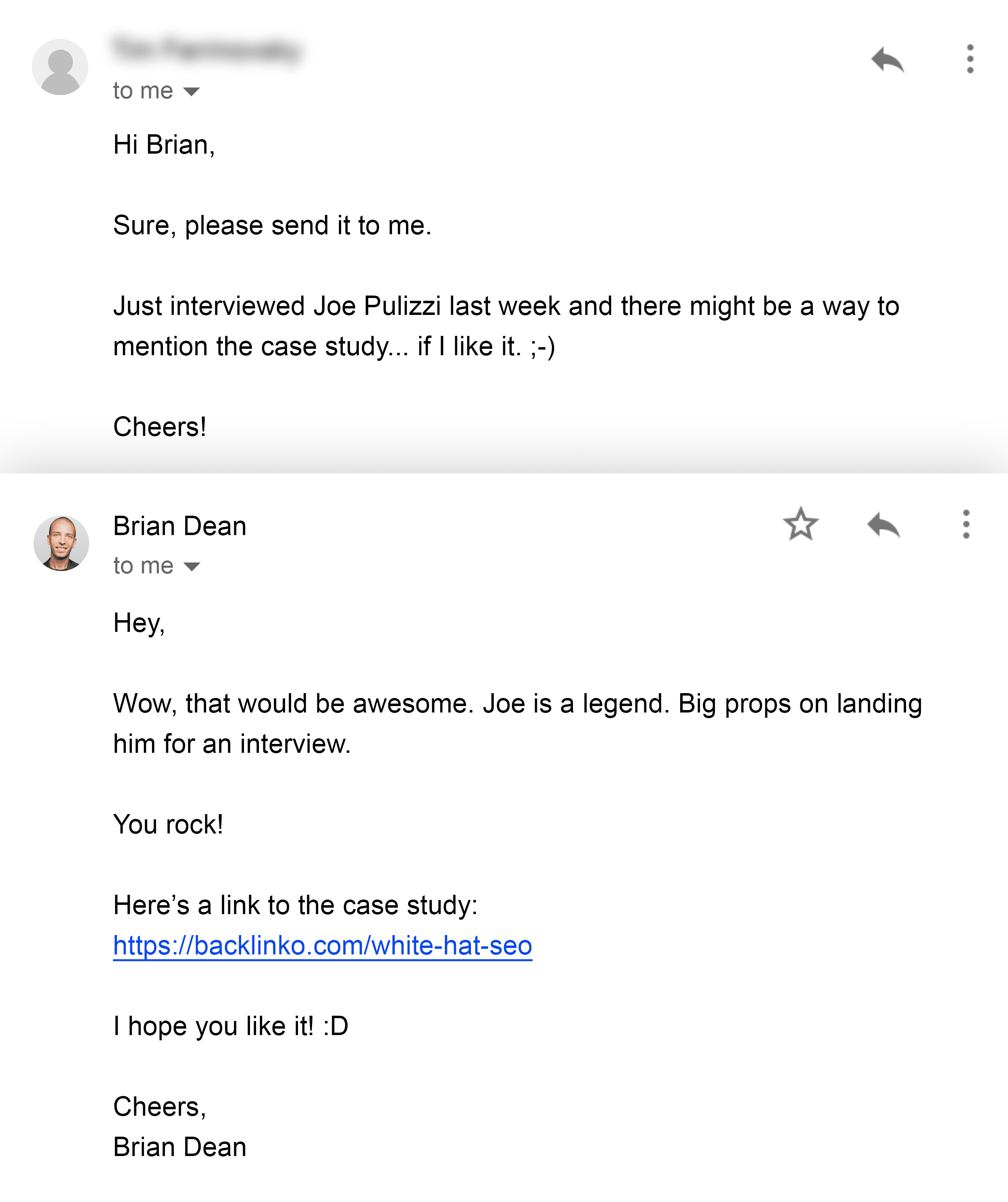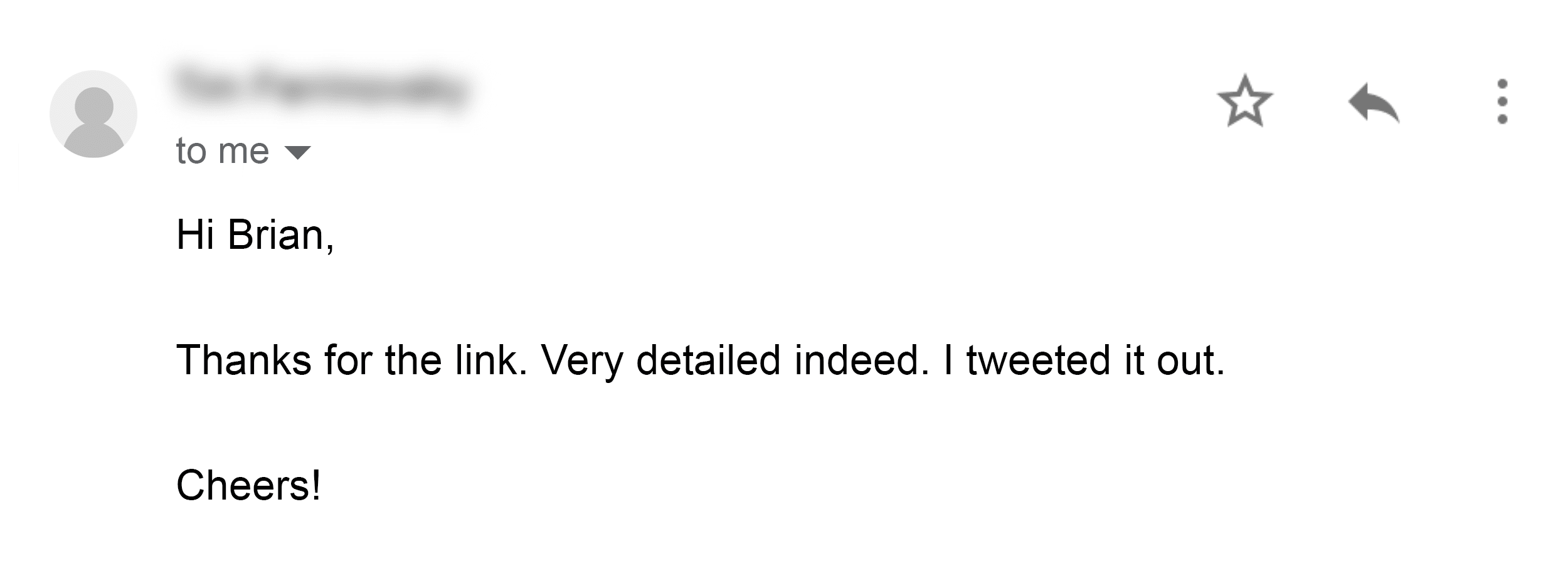28 Ways to Increase Traffic to Your Website
Written by Brian Dean

In this post, I’m going to show you how to drive more traffic to your website.
You’ll also see how I used these strategies to take my site from zero to 451K+ unique visitors per month:

It gets better:
All of these strategies are working GREAT right now.
With that, here’s how to increase website traffic using tried-and-true (and little-known) methods.
1. Overhaul and Upgrade Old Blog Posts
This simple strategy landed me over 22% more traffic year over year:

Here’s exactly how I did it:
First, I identified a post on Backlinko that was out of date.
As it turned out, my guide on the Skyscraper Technique could use a refresh.

So, I updated and improved the post.
Specifically, I added new screenshots:

And refreshed the content so it featured the latest strategies and techniques.
I also gave it a more straightforward title to reflect the post’s topic.
Finally, I updated the new post to make the changes live.

And just like that, traffic to that page shot up like a rocket ship.
This entire process took about two hours.
And I got WAY more SEO traffic than I would from publishing a new post.
2. Optimize Your Content With LSI Keywords
How do you make sure Google understands your content’s topic?
LSI keywords.
LSI keywords are words and phrases related to your target keyword.
But how do you find them?
One easy tactic is to type your target keyword into Google.
For this example, I used “content audit.”

Google’s autocomplete feature will suggest LSI keywords related to your topic based on what users are searching.
Like “content audit tool” and “content audit criteria.”
Then, just sprinkle these LSI keywords into your post…
And when Google sees these LSI keywords in your content, they say: “Great. This content is definitely about a content audit.”
Semrush’s Keyword Magic Tool can help you find even more related terms.

Note: A free Semrush account gives you 10 searches in Keyword Magic Tool per day. Or you can use this link to access a 14-day trial on a Semrush Pro subscription.
3. Create Helpful Content
Launched in August 2022, The Helpful Content Update is exactly what it sounds like: an algorithm update and ranking system designed to reward sites that create helpful, people-first content.

Basically…
- Google prioritizes content written for humans, not search engines
- They’re cracking down on AI-generated fluff and rewarding in-depth, expert content
Now, let’s talk E-E-A-T.
E-E-A-T stands for Experience, Expertise, Authoritativeness, and Trustworthiness.
It’s Google’s way of saying, “Show me you know your stuff.”
- Experience: Have you actually done what you’re writing about?
- Expertise: Do you have the knowledge to back up your claims?
- Authoritativeness: Are you recognized as a go-to source in your field?
- Trustworthiness: Can users rely on your information?
Incorporate E-E-A-T signals into your content to help boost your rankings.
And web traffic.
For example, every Backlinko author is a subject matter expert.
And this is highlighted with in-depth author pages that feature a bio and each writer’s expertise.
Like my author page:

And anyone else who writes for Backlinko, from internal editors to guest authors.

4. Get More Traffic From Your Blog Posts With “Content Transformation”
Content transformation is simple:
You simply convert one of your blog posts into another format (like an ebook, video, infographic, or podcast).
For example, I published this case study on my blog a while back:

As you can see, this post generated lots of social shares and comments.
But I knew that I could squeeze even more value out of this content.
So, I turned that post into a YouTube Video:

That single video has generated over 511k views… and hundreds of website visitors.
(All from a piece of content that I published YEARS ago.)
That’s the power of content transformation.
5. Go on Podcasts
Podcasts continue to be a popular way to reach your target audience.
(In fact, one survey found that 47% of Americans listen to podcasts once per month.)
Does that mean that you should grab the nearest microphone and start a podcast?
No.
Instead, I recommend going on other people’s podcasts as a guest.
This strategy works so well that I try to go on two to three podcasts per month.
In fact, I’ve appeared on over 100 podcast episodes:

And these episodes have brought me tens of thousands of visitors.
For example, I once got 984 visitors in 60 days from a single podcast episode:

As a bonus, you usually get at least one backlink in the show notes, which can help your search engine rankings:

And now it’s time for…
6. Get High-Quality Backlinks
Want to know how I got over 35K backlinks for my article, Google’s 200 Ranking Factors: The Complete List?

I created a monster resource.
This involved researching, compiling, and explaining 200+ potential ranking factors.

Next, I made it visually appealing.
I packed the post with custom graphics, charts, and screenshots.
This made the content more digestible.
And gave other sites a reason to embed my images—and link back to my article.

But SEO moves fast.
So, I updated this article often to ensure it stayed fresh.
And shareable.

Attract more backlinks—and web traffic—by doing the same.
Create a high-quality, comprehensive resource on an important topic in your industry.
Think:
- Expert quotes
- Original data
- Reputable studies
- Eye-catching image
- Authors with firsthand experience and expertise
7. Use the Content Relaunch Strategy
This is similar to technique #1 from this guide…
…with an important twist.
Instead of just improving your content, you completely relaunch it.
In other words:
Treat your new-and-improved content like a brand-new post.
For example:
I revamped and relaunched the old list of SEO copywriting tactics as a definitive guide:

So, I shared the post on social media:

And sent out an announcement to my newsletter subscribers:

Which led to a significant boost in traffic (including almost 10k visitors in one day):

8. Create Content That Appeals to Subject Matter Experts
Here’s the truth:
If you want influential people to share your content, you need to write stuff that appeals directly to that group.
Example:
A few years ago, I created an infographic for a client in the investing niche.
Even though that niche is far from “interesting,” our infographic went viral. We’re talking thousands of targeted visits in the first two days.
Here’s the infographic:

Now, there are dozens of reasons this infographic did so well… from the design to the content promotion campaign.
But a good chunk of its success was due to one simple thing:
It appealed to subject matter experts in the personal finance space.
I’ll explain.
I noticed that, at the time, a lot of high-powered financial bloggers were up in arms about inflation:

So, I decided to create an infographic that highlighted the problem they cared about.
And this led to shares and mentions on several authority sites…

…and a boatload of traffic.
9. Share Videos On LinkedIn
This study found that videos get the highest number of shares on LinkedIn.

What does this mean for you?
You need to post video content.
For example, here’s a video I posted on LinkedIn:

In about two weeks, my video got:
- 634 likes
- 106 comments
- 31 THOUSAND views
Try getting that kind of engagement on Facebook 🙂
Pro tip: YouTube isn’t the only place you should share videos. Go live on Facebook, create Instagram Stories, and post TikToks to engage your audience. The key to getting more website traffic? Include a compelling CTA to visit your website.
10. Host a Giveaway Contest
People love free stuff.
(No surprise there.)
But what might surprise you is: You can use free stuff to get more traffic.
How?
Host a giveaway contest.
Here’s an example of a contest my friend Noah Kagan put together:

See how that works?
To enter the contest, people need to enter their email address (which you then add to your email list).
It gets better:
You can incentivize people to share your contest with their friends:

(And those shares will drive more traffic to your website and grow your email list.)
Now:
This contest was done with KingSumo. But if you have the technical know-how, you can set this up yourself.
11. Add “Share Triggers” to Your Content
In my experience, content largely succeeds or fails based on one factor:
Whether or not the content has Share Triggers.
What are share triggers?
They’re things you include in your content that push people to share it.
A lot of these principles were first discovered by behavioral scientists like Dr. Jonah Berger, Dr. Katherine Milkman, and Jure Leskovec.

And they’ve proven in the lab what I discovered through trial and error:
When you include share triggers in your content, people are significantly more likely to share and link to it.
For example:
One of the most powerful share triggers is social currency.
Social currency is the idea that we share things that make us look good.
And this share trigger is a large part of the reason that The Shrinking Dollar infographic I mentioned earlier did so well.
Specifically, this infographic confirmed what influencers were already saying: inflation is a big problem.
And my content backed up their rants with meaty data:

Every time an influencer shared my infographic with their audience, it boosted their social currency.
So they shared it… again and again.
It even got included in Google News thanks to a feature in The Christian Post.

All because I strategically added the “social currency” share trigger into my content.
Very cool.
12. Retarget Visitors With Facebook Ads
Let’s face it:
Facebook ads are getting EXPENSIVE.
Fortunately, there’s a way to reduce your spend:
Retargeting.
Here’s how it works:
First, create a Facebook ad that sends people to a blog post.
Here’s a real-life example:

Next, target people who have visited your site in the last month or two:

Finally, run the ad.
And you’ll probably find that your CPC is dirt cheap vs. most other types of advertising (like Google Adwords).

Nice.
13. Publish Long-Form Content
A while back, we analyzed 912 million blog posts.
Why?
We wanted to see which TYPES of content worked best.
And we found that long-form content gets an average of 77.2% more links than short articles.

In fact, as you can see in the chart above, the longer the content, the better it does.
I’ve noticed the same thing myself.
For example, here’s a long-form blog post from my blog (a big list of SEO techniques):

This guide is over 4,000 words.
And the simple fact that my post is long is a big reason why it’s been shared over 14,000 times:

(And those shares have sent over 50,000 visitors to my website.)
14. Create an Active YouTube Channel
If you want to drive more traffic to your website, YouTube HAS to be on your radar.
Why?
YouTube is the 2nd most popular website on the planet (only behind Google):

In fact, YouTube is one of my top traffic sources (along with Google, Facebook, and referral traffic from blogs).
That said:
Getting views on your YouTube videos is HARD.
But it doesn’t have to be.
That’s why I’m going to point you to two resources that will help you get more views on your videos.
Resource #1: Video SEO: The Definitive Guide

This guide shows you EVERYTHING you need to know about ranking your videos in YouTube and Google.
It covers keyword research, video tags, and more.
Resource #2: YouTube SEO: How to Rank YouTube Videos
This guide will give you actionable tips that helped me rank #1 on YouTube for competitive keywords (like “SEO tutorial”):

15. Publish Viral Content
Is there a formula for creating content that goes viral?
Nope! Or else everyone would do it 🙂
That said, there ARE three things you can do to increase the odds that your content will spread like wildfire.
1. Use Lots of Visuals
These visuals can be a bunch of images. Or an infographic. Or a video.

The type of image doesn’t matter all that much. The important thing is that you use images in your content.
Why?
Content with visuals tends to get more likes, shares, and comments, according to Facebook.
2. Ensure It Has High “Utility”
This simply means your content is super useful in some way.
Maybe you show people how to steam broccoli.
Or you teach them to nail their job interview.

Either way, research shows that extremely practical content has a very high chance of going viral.
3. Give It an Initial “Push” to Get Going
For example, Chris Gimmer got over 17k visitors to his site in one day (thanks to a blog post that went viral):

And it wouldn’t have happened if Chris didn’t promote his content on sites like Reddit… which led to hundreds of visitors within hours.

16. Promote Blog Posts and Videos on Quuu
Quuu is a dead-simple way to get people to promote your content on social media.
All you need to do is submit your best content…
…and they’ll ask influencers to share it on Facebook, X, LinkedIn, and more.
Some time ago, I promoted one of my posts on Quuu. And got a handful of shares from influential people in the digital marketing space:

Not bad.
17. Republish Old Articles on LinkedIn
LinkedIn is an awesome place to syndicate your content.
For example, I published this study of YouTube ranking factors on my blog some time ago:

This post did well. Lots of people read my post and shared it on social media.
But I KNEW that there were thousands of people who could benefit from my content… but hadn’t seen it yet.
So, I republished my content as a LinkedIn article:

Which (along with my other LinkedIn posts) led to a decent chunk of targeted traffic:

18. Use a “Question Analyzer” To Create Insanely Useful Content
This strategy is an AWESOME way to make your content better.
(As you know, the better content = more traffic.)
All you need to do is:
- Find questions that your target audience asks online.
- Answer those questions in your content.
Here’s how to do it…
First, use a tool like Answer the Public to find questions that people ask:

Then, either create entire posts to answer these questions…

…or incorporate the answers into your content.

Simple.
19. Add Enticing Content to Social Media Posts
Here’s a mistake a lot of people make:
They share their content on social media… without giving people ANY reason to click.
Here’s an example:

I’m not judging. I used to do the same thing:

But I recently discovered that something:
Adding content to your posts can dramatically increase your CTR.
For example, when I tweet out a new post, I now include a bulleted list of features:

As you can see, that extra content leads to a ton of engagement:

(And clicks.)
Sweet!
20. Improve Your Organic Click-Through-Rate
I have some good news:
If you want more traffic from Google, you DON’T need higher rankings.
(Seriously!)
Instead, you can focus on improving your click-through rate (CTR).
For example, let’s say you rank #3 for your target keyword. And your CTR is 4%.

And let’s say that you double that CTR to 8%.

Well, you just doubled your organic traffic… without improving your rankings.
But wait, there’s more…
When you get a higher CTR, you might also improve your search engine rankings.

But how do you actually improve your CTR?
Here are a few tips that work great:
- Add a number to your title (like “21” or “98%”)
- Write a compelling meta description and title tag
- A/B test different titles and see which one gets the best CTR
- Use titles that are highly emotional
- Include your keyword in your URL
21. Publish More List Posts
There’s no way around it:
When it comes to driving traffic to your website, list posts work GREAT.
And there’s evidence to back this up.
(Besides the fact that you’re reading a list post right now. 😀 )
Like I mentioned way back in strategy #13, we analyzed 912 million articles a few years back.
Well, in that same study, we found that list posts CRUSHED all other content formats:

List posts get an average of 218% more shares than “how to” posts.
And 203% more shares than infographics.
And when I look at my own content, I notice the same thing.
For example, this mega list of Google’s ranking factors is one of my most shared pieces of content I’ve ever written.

It’s got over 47K shares:

22. Steal Your Competitors’ Traffic Sources
Imagine if you could see the EXACT places that send your competitors traffic.
That would be a goldmine, right?
Well, your competitors aren’t about to send you their Google Analytics password.
Fortunately, you don’t need it.
Why?
You can see all of their top traffic sources for free with SimilarWeb.
SimilarWeb not only shows you a sweet overview of a site’s traffic…

…but exactly where they get that traffic from.

Goldmine.
23. Drive Traffic to Your Website From Forums
Forums are an underrated traffic source.

But they’re also a slow burn.
You’ll need to be an active, long-term member who adds real value to conversations and communities—rather than just promoting your own site.
This builds trust and can lead to sustainable traffic growth over time.
Let me walk you through an example:
When I first got started with my blog, I was starting from scratch.
I had ZERO followers, ZERO visitors, and ZERO email subscribers.
So, to give my traffic a head start, I became an active member of a marketing forum.
I answered people’s questions…

…and even posted some original content:

And this led to a solid influx of visitors to my brand new blog.

Each forum will have its own rules on self-promotion.
But this tactic can work well—when done right—on forums and social media sites like the following:
- Quora
- X
- Facebook Groups
- Niche forums
- Threads
24. Syndicate Your Content on Medium
Medium.com is one of the BEST places to syndicate your best stuff.
In fact, I got 310 targeted visitors in a week from ONE Medium post:

310 visitors isn’t going to change my life or anything.
But they’re 310 visitors that took about 3 minutes to get.
All you need to do is repost your content on Medium.
Here’s an example of one of my Medium reposts:

Then, once your post is live, share it on all the usual suspects: X, Facebook, Threads, Instagram, and LinkedIn.
(This will give the post some juice.)
And when Medium sees that people are engaging with your post, they may start to promote it within their platform.

25. Promote Your Site With Blogger Outreach
So, you just published an awesome piece of content.
Now what?
It’s time to promote it with blogger outreach.
In fact, a blog post of mine got a nice spike in traffic largely due to a single tweet from an influential blogger:

The question is…
How?
All you need to do is find bloggers that share content on your topic…
…and send them a non-pushy email.
Here’s a real-life example of this process in action:
First, I sent a personalized email to a blogger that already shared content on my topic:

(That way, I knew she’d actually want to read my post… before I hit “send”.)
When she got back to me, I sent her a link to my content:

Pro Tip: Don’t ask the person to share your post. If they think your content is good, they’ll share it.
Because I wasn’t a pushy jerkface, this blogger was happy to spread the word:

That’s all there is to it.
26. Make Pinning a Priority
Pinterest traffic has insane longevity.
Unlike tweets or Facebook posts that disappear in hours, Pins can drive traffic for months or even years.
It’s the gift that keeps on giving.

And get this—Pinterest users are actively looking for ideas, products, and inspiration.
While the most popular categories on Pinterest change often, currently, the top 10 are as follows:
- Art
- Entertainment
- Home decor
- Design
- DIY and crafts
- Women’s fashion
- Beauty
- Education
- Event planning
- Quotes

If your niche doesn’t fit neatly into one of the categories above, don’t worry.
You’ll find everything from finance to architecture (and much more) on the platform.
Here’s how you can harness Pinterest’s power to drive serious web traffic:
- Create eye-catching, vertical Pins that stand out in users’ feeds. A free design tool like Canva can help you with this.
- Use keyword-rich descriptions to make your Pins discoverable.
- Link your Pins directly to relevant landing pages or your blog.
- Create pins consistently. While quality matters more than quantity, regular pins will help keep your content fresh and visible.
Pro tip: Create rich pins to drive more website traffic. These enhanced Pins automatically sync extra information from your website, like real-time pricing, recipe ingredients, or article headlines.
To create rich Pins, you’ll need to add metadata to your website and apply for rich Pins through Pinterest. Once approved, your Pins will automatically pull this extra info, making them more valuable and clickable to users.
27. Reduce Your Bounce Rate
A high bounce rate damages your site’s pageviews, conversions… and it can even hurt your SEO.
(In fact, thanks to Google’s RankBrain algorithm, bounce rate is now a super important ranking signal).
That’s the bad news.
The good news is that improving your bounce rate is insanely easy.
I walk you through the entire process in this blog post: What Is Bounce Rate? And How to Quickly Improve It.
28. Try the “Upside Down” Guest Post Strategy
Here’s the deal: Guest blogging isn’t what it once was.
But it’s still a viable way to get traffic to your website—as long as you’re allowed to include links to your content.
Yet, when most people read your guest post, they usually skip the author bio section.
I can’t blame them…
Most author bio boxes are BURIED at the bottom of the page, like this:

This is a huge problem.
If people don’t see your link in your author bio, they’re not going to visit your site.
Fortunately, there’s a simple solution to this problem: The “Upside Down” Guest Post.
Here’s the step-by-step process:
First, write a guest post just like you normally would.
Next, include “helpful resource” sections throughout your guest post.
These sections link to two to three helpful resources on the topic you just covered.
Here’s an example:

Finally, include YOUR content as one of the “helpful resources.”
For example, here’s a guest post I published a while back:

And I strategically linked to my content as one of the “resources to check out”:

And that link brought in 78% more traffic than my author bio link.

Pretty cool 🙂
Bonus Strategy #1: Post on Social Media at Strategic Times
So, CoSchedule analyzed the best times to post on social media networks (including Facebook, Instagram, X, and more).
Here’s what they found:

As you can see, they discovered that the best times to post on each network are:
- Facebook: 7 a.m., 3:15 p.m., 7 p.m.
- Pinterest: 12 p.m.,6:17 p.m., 8:02 p.m.
- Instagram: 9 a.m., 9:01 a.m., 7:59 p.m.
- LinkedIn: 1 a.m., 10 a.m., 12 p.m.
Bonus Strategy #2: Find More Keywords With “Keywords Everywhere”
Keyword research is THE most important part of SEO.
Question is:
How do you find untapped keywords that everyone and their mom doesn’t already know about?

Keywords Everywhere is a Chrome extension that gives you keyword ideas, well… everywhere.
Once you install the extension, the next time you do a Google search, you’ll see search volume and CPC data on that keyword:

Or the next time you’re shopping for bluetooth headphones on Amazon–BOOM–you see keyword data on the terms that Amazon suggests:

Grow Your Business and Your Website Traffic
I hope this post showed you how to increase website traffic using some cool, untapped strategies.
Which one will you try first?
Are you going to go on podcasts or create long-form videos for YouTube?
Or maybe you’re going to make Pinterest a bigger part of your traffic strategy.
Either way, you’ll want to make sure your website’s SEO is on point.
Read our guide, The 17 Most Important SEO Tips for Higher Rankings, to optimize your website for more traffic.

